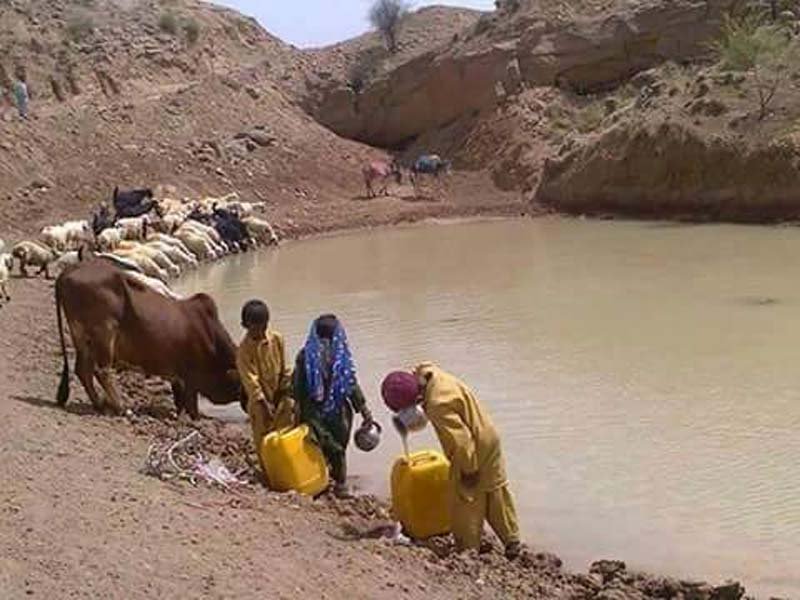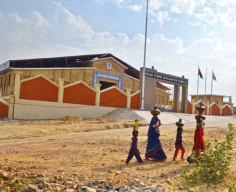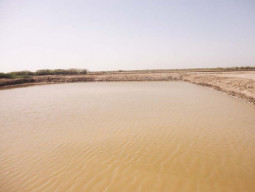
KAMBER-SHAHDADKOT: We are ready to provide a one-time meal but don’t ask us for drinking water, says Qurban Chandio, who lives in a hilly area that falls in the Kirthar mountain range in Kamber-Shahdadkot district.
Potable water, which is a basic amenity that must be ensured for all residents by the state, is a distant dream for the locals of this area. Qurban lives in a makeshift shanty village in Karo Har area of Gabi Dero union council, which lies around 54 kilometres from Kamber town. As he travels around three kilometres on his donkey to fetch water, he doesn’t seem perturbed by the fact that the pond from which he is collecting the water is shared by humans and animals. “All the wandering animals come here to quench their thirst,” he says while scratching his head. “We also fill our utensils from the same pond for drinking purposes.”
A few naked children bathe in the same pond from which animals and residents of the area quench their thirst. Meanwhile, a few women wash their clothes simultaneously as some sheep and cows drink from the pool. The fact that the same body of water — an accumulation of rainwater — is used for bathing, washing and is also accessible to animals for direct consumption raises questions on how safe the water is for humans.
According to Hawa Guramani of Sono Khan Chandio village, diarrhoea is a common disease among the children of the area. “This year, two children in our village had diarrhoea and vomiting and died on the way to the hospital,” he shares.
Official apathy
Access to potable water is not the only problem looming large in the faces of people living in scattered villages, including Sono Khan Chandio, Seeta, Kehri and Shaallo. Donkeys and camels are the common means of transportation in the villages as not even a single road has been built in the neglected areas. The areas fall under the domain of provincial assembly seat PS-42 and National Assembly seat NA-206, from where chieftains of Chandio and Magsi tribes, Nawaz Sardar Ahmed and Nawaz Aamir Magsi, respectively, have been elected.
According to local residents, politicians, elected representatives and non-governmental organisations (NGOs) have neglected their regions in similar manner. An elderly woman, Hawa Guramani, walks barefoot. “If nothing else, drinking water should be provided to us,” she says. “I, along with other women of this area, have spent most of my life searching the sweet water wells and reservoirs as underground water is not fit for drinking.” The abject poverty that these people live in reflects from their faces.
“It takes around a half day to reach district headquarter Kamber, which is hardly a one-hour drive of a car if roads are built,” says a herdsman, Ghulam Mohammad Marfani. According to him, in cases of emergencies, they carry their loved ones on camels and donkeys to reach a nearby small town, Gabi Dero, wherefrom they get transport. “There is only one bus on this route, which leaves for Kamber early morning and comes back before sunset,” he says.
Since the land is barren, people’s source of income is mostly livestock. “We grow different kind of vegetables and crop when rain lashes this area,” shares Marfani. However, he adds, lots of animals and people, especially children, die in the area due to malnutrition and drought, which hits the area every year. “No one takes notice,” he laments.
Official version
When The Express Tribune tried to contact Nawab Aamir Magsi, he did not attend the phone. Meanwhile, Nawab Sardar Ahmed Chandio, the most influential person of this area, counted a number of initiatives on his part. “We have included some roads schemes in the annual development plan and provided water to those areas where contamination level is high,” he said, adding that a few Reverse Osmosis (RO) plants have also been installed in nearby town so that people can get potable water.
“We have also started tanker service in some areas,” he said, adding that the right bank outfall drain, which carries the contaminated water from Balochistan, has created a mess by contaminating the underground water. “The drain’s poisonous water penetrates wherefrom it crosses,” he said. According to him, the water crisis has worsened due to lack of rains in the area.
Shamshir Bhutto, the deputy commissioner of the area, said that he has recently taken charge and will probe into the problems. His assistant said that the district government has installed solar panels in these villages to resolve electricity and drinking water issue. He added that water pumping wind mills will be installed and this scheme is in the process of approval.
Published in The Express Tribune, January 2nd, 2017.




























































COMMENTS (2)
Comments are moderated and generally will be posted if they are on-topic and not abusive.
For more information, please see our Comments FAQ